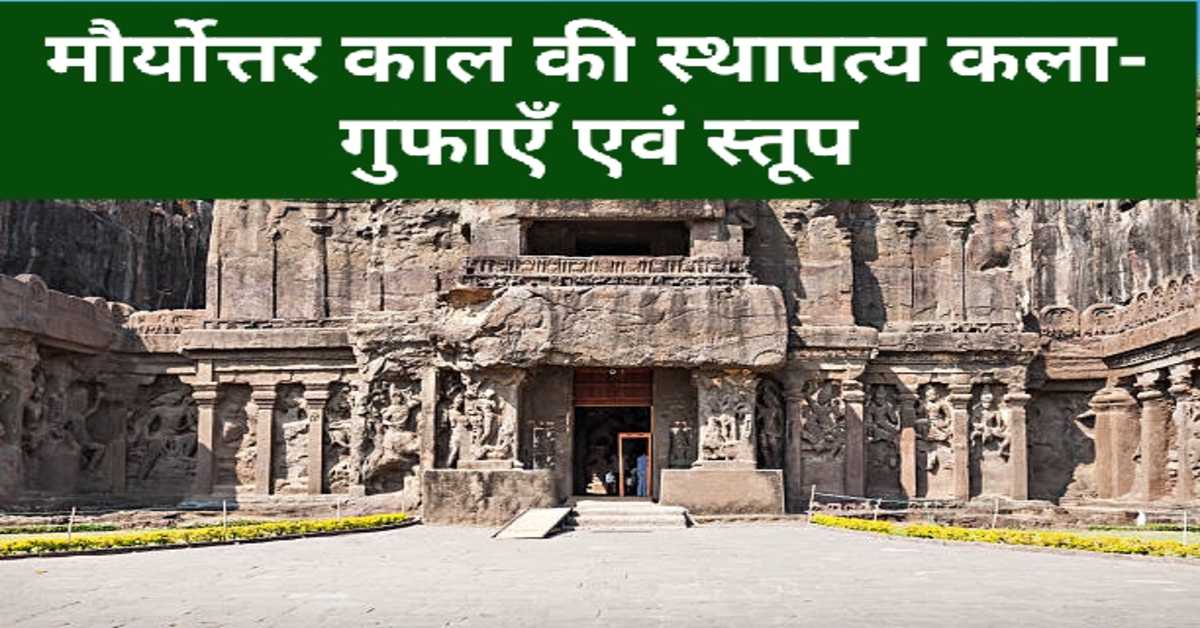
मौर्योत्तर काल की स्थापत्य कला- गुफाएँ एवं स्तूप | Architecture of the post-Mauryan period - caves and stupas
मौर्योत्तर कालीन स्थापत्य कला के अंतर्गत निम्नलिखित वास्तुशिल्प सम्मिलित हैं-
The architecture of the post-Mauryan period includes the following architecture-
चट्टानों को काटकर बनायी गयी गुफाएँ- मौर्य काल की भाँति मौर्योत्तर काल में भी चट्टानों को काटकर गुफा बनाने की प्रथा चलती रही। हालाँकि तत्कालीन समय में ये गुफाएँ दो भागों चैत्य और विहार में विभाजित हो गयीं। विहार बौद्ध एवं जैन भिक्षुओं के आवासीय कक्ष होते थे। इनका निर्माण मौर्य काल से ही आरंभ हो गया था। चैत्य का विकास इस अवधि में हुआ। चैत्य समतल छत वाले चतुष्कोणीय कक्ष होते थे। ये मुख्य रूप से प्रार्थना कक्ष होते थे। इन गुफाओं में बारिश और खुले प्रांगण से बचने के लिए पत्थर-रोड़ी की दीवारें बनायी जाती थीं। इन दीवारों पर मानव और पशु की आकृति अंकित की जाती थीं।
उदाहरण- कार्ले के चैत्य, अजंता की गुफाएँ (29 गुफाएँ- 25 विहार + 4 चैत्य)
Caves made by cutting rocks- Like the Mauryan period, the practice of making caves by cutting rocks continued in the post-Mauryan period. However, at that time these caves were divided into two parts chaitya and vihara. Viharas were the residential halls of Buddhist and Jain monks. Their construction started from the Maurya period itself. The development of Chaitya took place during this period. Chaityas were quadrangular chambers with flat roofs. These were mainly prayer halls. These caves were made of stone-pasted walls to protect them from rain and open courtyards. Human and animal figures were inscribed on these walls.
Examples- Chaityas of Karle, Ajanta Caves (29 Caves- 25 Viharas + 4 Chaityas)
"भारतीय कला एवं संस्कृति" के इन 👇 प्रकरणों को भी पढ़ें।
1. भारत की वास्तुकला, मूर्तिकला एवं मृद्भाण्ड
2. हड़प्पा सभ्यता के स्थल एवं उनसे प्राप्त वास्तुकला एवं मूर्तिकला के उदाहरण
3. हड़प्पा सभ्यता की वास्तुकला
4. हड़प्पा सभ्यता की मोहरें
5. हड़प्पा सभ्यता की मूर्ति कला
6. हड़प्पा सभ्यता से प्राप्त मृद्भाण्ड एवं आभूषण
उदयगिरि एवं खंडगिरि की गुफाएँ- वर्तमान भुनेश्वर में प्रथम-द्वितीय शताब्दी ईसा पूर्व में कलिंग के राजा खारवेल ने इन्हें बनवाया था। इन गुफा समूहों में प्राकृतिक एवं मानव निर्मित दोनों प्रकार की गुफाएँ हैं। संभवतः इन गुफाओं का निर्माण जैन भिक्षुओं के निवास के लिए करवाया गया था। उदागिरी में 18 और खंडगिरि में 15 गुफाएँ हैं।
उदयगिरि की गुफाओं में हाथीगुंफा अभिलेख उत्कीर्णित है। यह ब्राह्मी लिपि में उत्कीर्णित है। इस अभिलेख का आरंभ 'जैन नमोकर मंत्र' से होता है। आगे इस अभिलेख में राजा खारवेल द्वारा किये गये कार्यों एवं विजय अभियानों का वर्णन है। उदयगिरी रानीगुम्फा के लिए भी प्रसिद्ध है। यह दो मंजिला गुफा है। इसमें कुछ सुंदर मूर्तियाँ भी हैं।
Udayagiri and Khandagiri Caves- These were built by King Kharavela of Kalinga in the 1st-2nd century BC in present day Bhubaneswar. These cave groups have both natural and man-made caves. Probably these caves were built for the residence of Jain monks. There are 18 caves in Udagiri and 15 in Khandagiri.
Hathigunfa inscription is engraved in the Udayagiri caves. It is engraved in Brahmi script. This inscription begins with 'Jain Namokar Mantra'. Further, this inscription describes the works and conquests done by King Kharavela. Udayagiri is also famous for Ranigumpha. It is a two storeyed cave. It also has some beautiful sculptures.
"भारतीय कला एवं संस्कृति" के इन 👇 प्रकरणों को भी पढ़ें।
1. मौर्य कला एवं स्थापत्य कला
2.मौर्य काल की दरबारी कला
3. मौर्य काल की लोकप्रिय कला
4. मौर्योत्तर कालीन कला की जानकारी
स्तूप- मौर्योत्तर काल में स्तूप अधिक अलंकृत और विशाल होते गये। लकड़ी और ईटों के स्थान पर प्रस्तर का प्रयोग अधिक हो गया। शुंग राजवंश ने स्तूपों के सुंदरतापूर्वक अलंकृत प्रवेश द्वारों के रूप में तोरणों का निर्माण करवाया। तोरणों में अलंकृत जटिल आकृतियों, मूर्तियों और पेटर्नों का प्रयोग किया गया था। इन पर हेलेनिस्टिक या ग्रीक प्रभाव देखा जा सकता है।
उदाहरण- मध्य प्रदेश के भरहुत का स्तूप, साँची के स्तूप का तोरण आदि।
Stupas- Stupas became more ornate and larger in the post-Mauryan period. Instead of wood and bricks, stone was used more. The Sunga dynasty built pylons as the beautifully ornate entrances to the stupas. Ornate intricate figures, sculptures and patterns were used in the pylons. Hellenistic or Greek influence can be seen on these.
Example- Stupa of Bharhut of Madhya Pradesh, Torna of Stupa of Sanchi etc.
इन 👇एतिहासिक महत्वपूर्ण प्रकरणों को भी पढ़ें।
1. मौर्य साम्राज्य प्राचीन भारत का गौरवशाली इतिहास
2. पाटलिपुत्र (मगध साम्राज्य) पर शुंग वंश का शासन
3. भारत का प्राचीन इतिहास - कण्व वंश
4. प्राचीन भारत का आन्ध्र सातवाहन वंश
5. भारत में हिन्द-यवन वंश का शासन
आशा है, उपरोक्त जानकारी परीक्षार्थियों / विद्यार्थियों के लिए ज्ञानवर्धक एवं परीक्षापयोगी होगी।
धन्यवाद।
R F Temre
rfcompetition.com
आशा है, उपरोक्त जानकारी उपयोगी एवं महत्वपूर्ण होगी।
(I hope the above information will be useful and important. )
Thank you.
R. F. Tembhre
(Teacher)
pragyaab.com




Comments